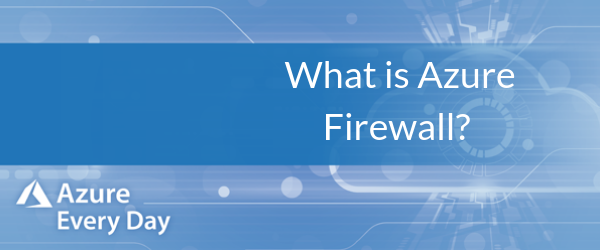Implement Platform Protection: Azure Firewall (Part 2)
To read part 1 please click here
Azure Firewall
- Built-in high availability- As high availability is built in, no additional load balancers are required and there is nothing you need to configure.
- Unrestricted cloud scalability- Azure Firewall can scale up as much as you need, to accommodate changing network traffic flows so you don't need to budget for your peak traffic.
- Application FQDN filtering rules- You can limit outbound HTTP/S traffic to a specified list of FQDNs, including wild cards. This feature does not require SSL termination.
- Network traffic filtering rules- You can centrally create, allow, or deny network filtering rules by source and destination IP address, port, and protocol. Rules are enforced and logged across multiple subscriptions and virtual networks.
- FQDN tags- Fully qualifies Domain Names (FQDN) tags make it easier for you to allow well known Azure service network traffic through your firewall.
- Outbound Source Network Address translation (OSNAT) support- All outbound virtual network traffic IP addresses are translated to the Azure Firewall public IP. You can easily identify and allow traffic originating from your virtual network to remote internet destinations.
- Inbound Destination Network Address Translation (DNAT) support- Inbound network traffic to your firewall public IP address is translated and filtered to the private IP addresses on your virtual networks.
- Azure Monitor logging- All events are integrated with Azure Monitor, allowing you to archive logs to a storage account, stream events to your Event Hub, or send them to Azure Monitor logs.
After grouping the features above into logical groups we can determine that Azure Firewall has three rule types- NAT rules, network rules, and application rules.
NAT rules
Inbound connectivity can be configured by configuring DNAT. First of all, filter inbound traffic with Azure Firewall DNAT using the Azure portal. DNAT rules are applied first and if a match is found, an implicit corresponding network rule to allow the translated traffic is added. You can also override this behavior by explicitly adding a network rule collection with deny rules that match the translated traffic. No application rules are applied for these connections.
Firewall rules to secure Azure storage
Azure Storage provides a layered security model, which enables you to secure your storage accounts to a specific set of supported networks. An application that accesses a storage account when network rules are in effect requires proper authorization on the request. By default, storage accounts accept connections from clients on any network and to limit its access to selected networks, you must first change the default action. You should be sure to grant access to any allowed networks using network rules before changing the default rule to deny access.
Azure Firewall Implementation
- Application rules that define Fully Qualified Domain Names (FQDNs) that can accessed from a subnet.
- Network rules that define source address, protocol, destination port, and destination address.
Network traffic is subjected to the configured firewall rules when you route your network traffic to the firewall as the subnet default gateway.
Firewall Concepts
Controlling the outbound network access is an important part of an overall network security plan and you can control it with Azure firewall by configuring Application rules that define source address, protocol, destination port, and address. Network traffic is then subjected to the configured firewall rules when you route your network traffic to the firewall as the subnet default gateway.
FQDN Tags
- Compute access to storage Platform Image Repository (PIR).
- Managed disks status storage access.
- Azure Diagnostics and Logging (MDS).
Threat intelligence-based filtering
It can be enabled for your firewall to alert and deny traffic from/to known malicious IP addresses and domains. If the threat intelligence-based filtering is enabled, the associated rules are processed before any of the NAT, network, or application rules. You can choose to just log an alert when a rule is triggered, or you can choose alert and deny mode. By default threat an intelligence-based filtering is enabled in alert mode.
Service tags
A service tag represents a group of IP addresses prefixes to help minimize complexity for security rule creation. Microsoft can easily manage the address prefixes encompassed by the service tags, and automatically updates the service tag as and when the addresses change. Azure Firewall Service Tags can be used in the network rules destination field and also in the place of specific IP addresses.
Remote Work Support
VPN Forced Tunneling
- On-premises network- A private local-area network running within an organization.
- VPN device- A device or service that provides external connectivity to the on-premises network.
- VPN virtual network gateway or ExpressRoute gateway- The virtual network gateway enables the virtual network to connect to the VPN device, or ExpressRoute circuit, used for connectivity with your on-premises network.
- Hub virtual network- The virtual network used as the hub in the hub-spoke topology.
- Gateway subnet- The virtual network gateways are held in the same subnet.
- Spoke virtual networks- One or more virtual networks that are used as spokes in the hub-spoke topology.
- Virtual network peering- Two virtual networks can be connected using a peering connection.





Comments
Post a Comment